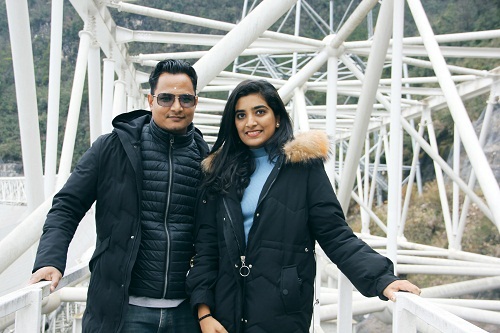

I am Bhusan Kayastha from Nepal, a PhD student at National Astronomical Observatories of the Chinese Academy of Sciences (NAOC). I am a CAS-TWAS President’s Fellow at the University of the Chinese Academy of Sciences (UCAS). Every year, the International College of UCAS (IC-UCAS) organizes a Winter School on Frontier and Interdisciplinary Sciences for the international students of UCAS focusing on the pertinence and crossover of subjects as well as scientific- educational integration. This year, NAOC and the FAST Observatory hosted the Winter School from January 10 – 15 at Pingtang County, Guizhou to present students with cutting-edge theories and research methods in astronomy and physical engineering.

Bhusan Kayastha and Sunayana Maben, PhD students from NAOC at the FAST site
As an astrophysicist, I was already excited about visiting the FAST station when I heard about its opening ceremony in September, 2016. As soon as this year’s Winter School was announced and I learned that it was going to be held at the FAST station, it was like a dream come true. With great excitement in our hearts, I and 41 other students from UCAS, along with our teachers, landed at the Guiyang International Airport. The weather was cold, and the beautiful mountains were surrounded by fog. We crossed many mountains and tunnels during our 150km road trip to reach the Pingtang Astronomical Town. It was almost evening when we arrived at the Winter School venue. As soon as we went through the gate of our hotel we could feel the astronomical ambience with telescopes and paintings of the solar system in the lobby. It was such a nice environment somewhere deep in the mountains of Guizhou.

FAST Observatory at Guizhou, China
FAST stands for Five-hundred-meter Aperture Spherical Radio Telescope. It is the world’s largest and most sensitive filled-aperture radio telescope. Located in the Dawodang depression, a natural basin in Pingtang County, Guizhou province, China, it consists of a fixed 500 m diameter dish constructed in a natural depression.

Night View of the Pingtang Astronomical Town
The Winter School started with a welcoming speech by Prof. Dr. Gang Zhao, Legal Representative and Executive Deputy Director-General of NAOC. Over the following days there were presentations and lectures related to astronomy by various professors.
On the second day, during the breakfast at the hotel restaurant, I met some junior high school students on a school tour of the FAST observatory from Guangzhou Baiyun Experimental School. They had already been to the FAST site a day before. I had a conversation with them and I asked them about their feelings after visiting the FAST station. One of the students, Zhang Yiting, who is 13 years old, said “We are a group of 23 students and we came here on a 4-day tour from Guangzhou. When I saw the FAST site, it was like a big golf ball surrounded by many towers. We went around the telescope - it was like walking on a bridge. I feel proud of my country; it is the largest telescope in the world. I want to be an astronomer now and want to use this instrument to find new stars in the future”.
On the same day, we had the most exciting part of the Winter School – the tour of the FAST station. The FAST observatory imposes radio silence within a 5km radius so we were not allowed to carry any mobile phones with us. While we were walking towards the FAST site, from far away I saw a big tower more than 100 meters tall. As we went nearer, I saw a big white circular dish of 500 meters diameter surrounded by six tall towers with a height of more than 100 meters. The circular dish was constructed by joining many small triangular plates with a receiver in the center connected by cables to the six surrounding towers. There is a bridge-like walking path supported by pillars to the ground around the circular dish where visitors can walk. The construction of FAST started in June, 2011, and was completed in September, 2016. It is still going through the final stage of construction and will be completed by September, 2019.
As of January, 2019 FAST has discovered 74 new pulsars, 54 of which have been verified through radio telescopes in other countries. Everyone was excited and happy to see the largest radio telescope in the world. We took many pictures and filmed the “New Year Greetings of UCAS” for the upcoming Spring Festival -- the Chinese New Year. This year marks the 70th anniversary of the founding of the People’s Republic of China, and I believe FAST is one of the landmark achievements of the Chinese people in these years.
In the evening, we went to see the light show at the Pingtang Astronomical Town. The whole city was glowing. There were street lamps which looked like flying saucers and UFOs. There was music coming from a building which looked like a space station with a lighting system designed as a tree in the middle. There was a Milky Way section near the river with big bulbs representing Saturn and Jupiter. To be in such a nice astronomical ambience in the midst of the mountains nearby the lake made us extremely happy.
The planetarium was in the middle of the Astronomical Town; we visited it the next day. It was like visiting a museum introducing different aspects of astronomy like the history of radio astronomy and of the solar system, the evolution of the universe from the big bang, black holes, spaceships, rockets and much more. It was the first time in my life that I saw a movie in a golf ball shaped hall with 3D effects. Where else on earth will you encounter an astronomical town, a hotel filled with astronomical atmosphere and a telescope on the balcony of every room? This is the Pingtang Astronomical Town in Guizhou.
The Winter School ended with a dinner program and special performances from the Bouyei ethnic minority group of Guizhou and the participating international students of UCAS. This Winter School was a good platform to learn about astronomy and get a practical feeling of the FAST observatory. The school made it possible for students from different scientific fields and institutes of the Chinese Academy of Sciences to come together and share their ideas. It was a very fruitful Winter School for us and we had the experience of a lifetime. I would like to sincerely thank NAOC, the FAST Observatory, UCAS, CAS and all the teachers for giving us such a wonderful opportunity.
Source: NAOC